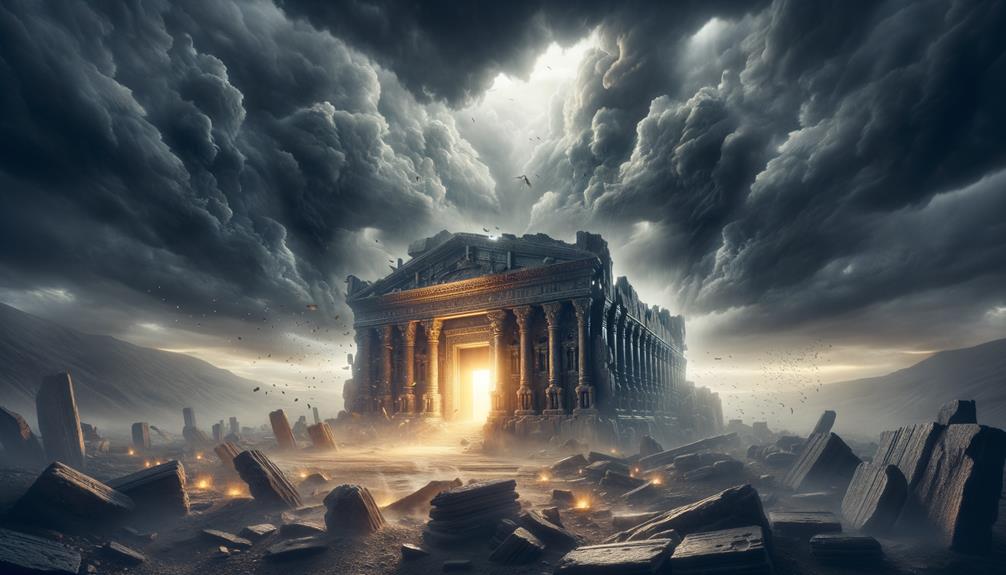Theories about the Ark of the Covenant, a revered artifact from biblical times, are as diverse as they are intriguing. One such theory weaves a tale of Menelik whisking it away to Ethiopia, a story that is detailed in the Kebra Negast. Some even think that it might currently be housed in the Church of St. Mary of Zion in Aksum. Another train of thought posits that it was annihilated during the Babylonian invasion in 586 BC, suggesting it was destroyed along with King Solomon’s Temple. Some theorists, on the other hand, believe it might be hidden somewhere in Jerusalem or that its location is being kept a secret by divine intervention. The final whereabouts of the Ark remains an enigma, a biblical puzzle that continues to captivate our collective curiosity.
Biblical Depiction of the Ark
In the Bible, the Ark of the Covenant is presented as a holy box, crafted from acacia wood and gold. It’s thought to have been a physical representation of God’s presence here on Earth. Inside this sacred box were the Ten Commandments, Aaron’s rod, and a jar of manna. These items represented divine direction, power, and nourishment. King Solomon kept the Ark in the Holy of Holies, the most sacred part of his temple. The Old Testament last mentions the Ark in 2 Chronicles 35:3, and after that, it’s as if it just vanished. The account given by Jeremiah leaves us with more questions than answers about its mysterious disappearance. Did it get hidden in Jerusalem to keep it safe from the Babylonian invaders? Or did it somehow end up in the hands of the Ethiopian Orthodox Tewahedo Church? These unsolved mysteries continue to fuel our curiosity and speculation.
The Ethiopian Connection Theory

Let’s chat about an intriguing theory tied to the history of the Ark of the Covenant, known as the Ethiopian Connection Theory. This theory suggests that Menelik, the offspring of King Solomon and the Queen of Sheba, whisked the Ark off to Ethiopia. This fascinating idea is deeply rooted in Ethiopian Orthodox tradition and is evident in several aspects:
- There’s a conviction that the Ark rests in the Church of St. Mary of Zion in Aksum.
- The tale of the Ark’s trek is told in the Kebra Negast, which links Ethiopia’s Solomonic dynasty to King Solomon.
- Tabots, or replicas symbolizing the Ark’s existence, are highly respected.
- Tradition dictates that a virgin monk is the Ark’s guardian.
Together, these factors uphold Ethiopia’s assertion, introducing an air of intrigue to the Ark’s tale.
Theory of the Arks Destruction

Let’s chat about a fascinating theory regarding the Ark of the Covenant‘s fate. Some believe that it might have been destroyed during the Babylonian invasion of Jerusalem in 586 BC. According to this idea, the Ark could have met the same end as King Solomon’s Temple on the Temple Mount – total destruction. The Ark’s abrupt absence from historical records after the invasion adds some credibility to this theory.
| The Ark | Temple Mount | Babylonian Invasion |
|---|---|---|
| Believed to have been destroyed | Site of Solomon’s Temple | Took place in 586 BC |
| No trace in historical records post-invasion | Temple was demolished | Led to the Ark’s sudden absence |
| Its fate is still a mystery | Important site in history | Altered Jerusalem’s history |
While definite proof is missing, this theory does offer a plausible reason for the Ark’s sudden vanishing.
When rewriting sentences, keep the language simple and clear. Avoid overcomplicating things with jargon or technical terms. Use current, relevant language that your audience will understand and avoid overused phrases. Rather than relying on generic transition words, aim for a natural flow in your writing. Exaggerated language can harm your credibility, so stick to the facts and support your claims with evidence where possible. Always consider your audience and adjust your language accordingly. Use an active voice for clearer, more direct writing. Instead of simply stating that something is ‘important,’ explain why it’s significant. This makes your content more engaging and easier to understand.
The Ark in Popular Culture

The Ark of the Covenant isn’t just a religious artifact. Its enduring appeal, coupled with its mysterious disappearance, has made it a popular icon in the world of entertainment. You’ve no doubt seen the Ark feature in films like ‘Raiders of the Lost Ark,’ and you’ve probably come across it in various TV shows, books, and video games too. The story of Indiana Jones racing against time to keep the Ark’s power from falling into the wrong hands echoes King Solomon’s efforts to protect it in Biblical times.
- Some people believe that Christian tradition hints at the Prophet Jeremiah being the one who took the Ark, an idea that’s been played around with in several fictional works.
- Another theory that’s caught on is that the Ark ended up in Ethiopia, in the Church of St. Mary of Zion to be precise.
- When it comes to the Ark’s role in pop culture, it’s often seen as a symbol of divine power or judgment.
- The Ark is linked with dangerous adventures and ethical quandaries quite a bit.
- The fact that we don’t know much about the Ark’s history only adds to its appeal, making it an interesting plot device in stories.
Debates on the Arks Final Fate

There’s been a lot of chatter about what actually happened to the Ark of the Covenant. Some scholars are convinced it was nabbed by the Babylonians, others believe it was stashed away in Jerusalem, and a few even think it was transported to the remote corners of Ethiopia. If we look at the Book of Exodus, which is a key reference, it doesn’t give us a clear answer. Jewish tradition points to King Josiah hiding the ark around the seventh century BCE. However, some counter that argument saying it was snatched up by the Babylonians during their invasion. There are also those who propose that Yahweh wouldn’t let His Ark get captured, so its location might continue to be a mystery. Despite rigorous research, we still can’t pinpoint the Ark’s final resting place, making it a biblical riddle of epic scale.
Frequently Asked Questions
Is There Historical Evidence of the Ark of the Covenant?
Absolutely, there is historical reference to the Ark of the Covenant, with the most substantial evidence found in the Hebrew Bible. But, the real conundrum lies in the fact that we don’t know its exact whereabouts. You see, there’s a gap in the archaeological records and clear historical documents after 586 BC, making it a bit of a historical puzzle.
Where Do Historians Think the Ark of the Covenant Is?
So, where could the Ark of the Covenant be, you ask? Well, honestly, nobody really knows. Some folks who study history are inclined to think it might be tucked away somewhere in Babylon. Others, on the other hand, are of the opinion that it’s stashed away in a hidden spot in Jerusalem. However, there’s no shortage of theories. Some even suggest it could be in places as far-flung as Ethiopia, France, or Rome. It’s a fascinating mystery that continues to pique our curiosity.
When Was the Last Time the Ark of the Covenant Was Seen?
You know, the last sighting of the Ark of the Covenant actually goes way back. It was before the Babylonians showed up in 586 BC. Ever since, its whereabouts have been a mystery, and this has led to countless theories about where it could possibly be now.
Who Could Approach the Ark of the Covenant?
Did you know that the Ark of the Covenant was not something anyone could just walk up to? In fact, it was only the high priest of Israel who was allowed to go near it. And even then, there was a strict rule about when they could do so – only once a year on the Day of Atonement. Any other attempts to interact with the Ark without proper authority were believed to result in death! It’s quite the cautionary tale, isn’t it?
